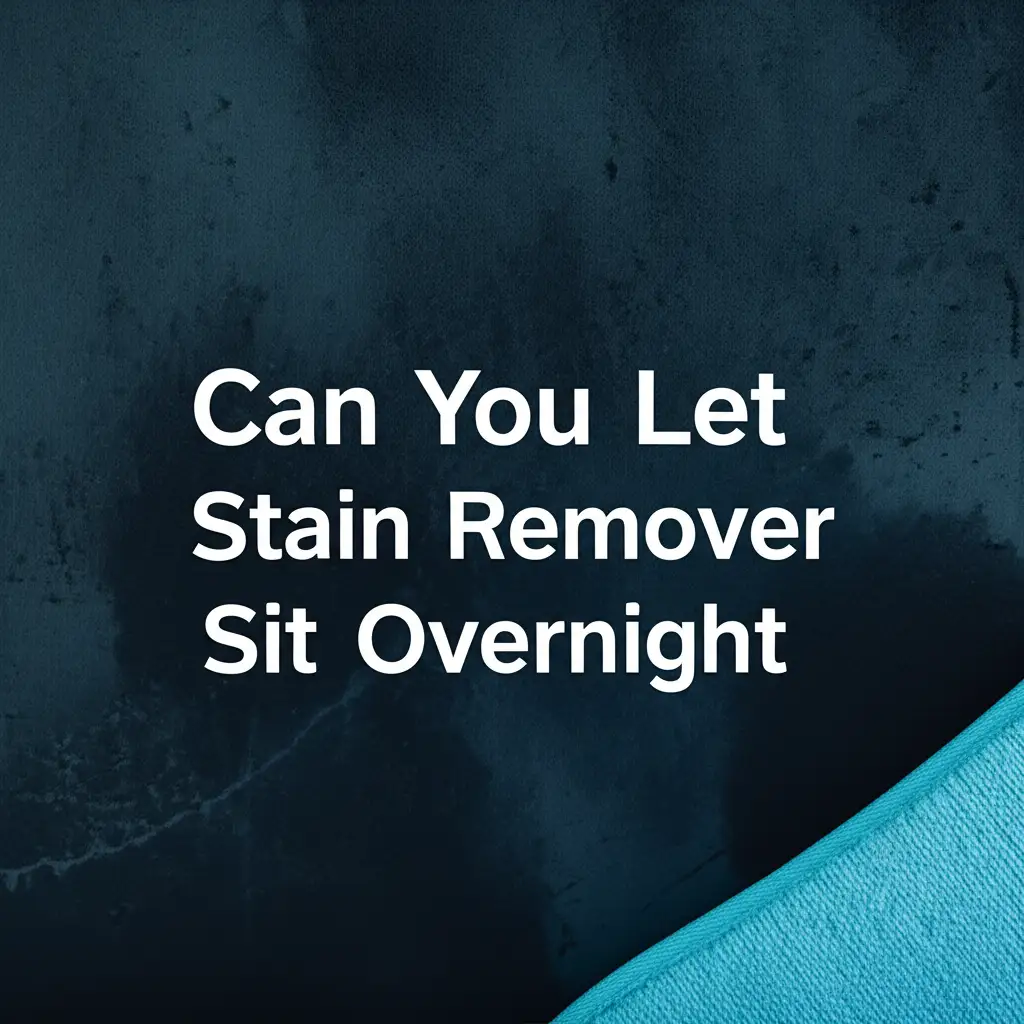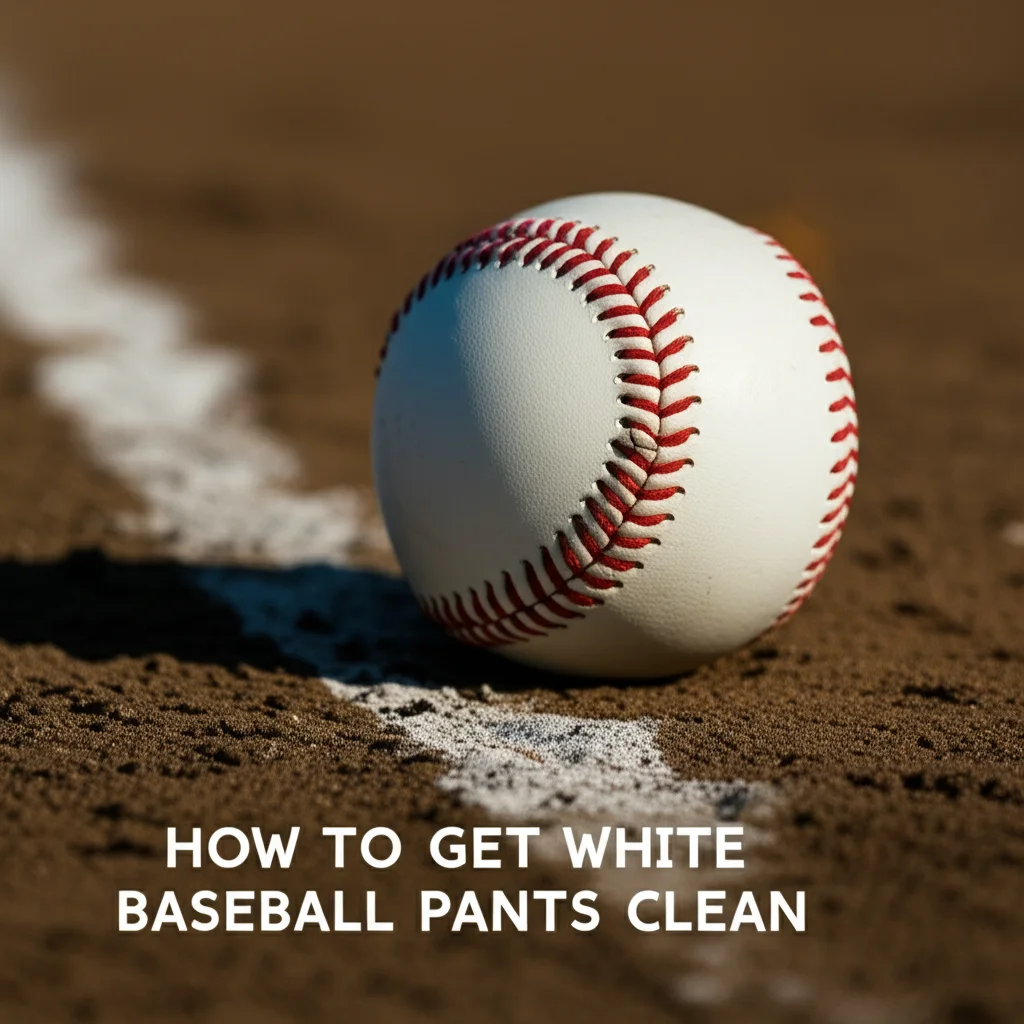· Todd Martin · Laundry Care · 17 min read
Can You Let Stain Remover Sit Overnight

Can You Let Stain Remover Sit Overnight: The Ultimate Guide
We all face those stubborn laundry stains. A spilled coffee, a grass mark from playing outside, or a dreaded grease spot. Many people wonder if they can simply apply a stain remover and let it sit overnight. This approach seems appealing for tough spots, promising a deeper clean with minimal effort. But is it safe for your clothes and effective for all stains?
This article answers the important question: Can you let stain remover sit overnight? We will explore the science behind stain removers, discuss when extended soaking is beneficial, and warn you about potential risks. You will learn how different fabric types react and discover the best practices for handling various stain remover products. My aim is to give you clear guidance so you can tackle stains with confidence.
Takeaway
- Check your stain remover’s label for specific instructions.
- Overnight soaking can help with old, dried-in stains on durable fabrics.
- Delicate fabrics, bright colors, and certain stain remover types do not tolerate extended soaking.
- Always test the stain remover on an unseen area first.
- Rinse treated items thoroughly after any extended treatment.
Can You Let Stain Remover Sit Overnight?
You can let stain remover sit overnight in some situations, but not always. It depends on the specific stain remover product, the fabric type, and the stain itself. Always check the product label for maximum recommended treatment times. Leaving it on too long can sometimes damage fabric or remove color.
Understanding Stain Remover Action: Why Time Matters
Stain removers work by using chemicals to break down the bond between the stain and the fabric fibers. Different types of removers use different chemical processes. Some products contain enzymes, which are biological agents that eat away at protein or starch-based stains. Others use oxygen boosters to lift dirt and color. Acidic or alkaline agents can also target specific stain types.
The time a stain remover needs to work is important. It needs enough time for its active ingredients to penetrate the stain. This allows the chemicals to start dissolving or lifting the stain particles. However, there is a limit to this process. After a certain point, the helpful action can turn harmful.
When you leave a stain remover on too long, it can continue to react with the fabric itself. This is especially true for stronger chemicals. The product might start to degrade the fabric fibers. It could also strip away the dye, leading to faded spots or permanent discoloration. Understanding this balance helps you use stain removers safely and effectively.
The Case for Overnight: When Longer Soaking Helps
Sometimes, an overnight soak with a stain remover is exactly what a stubborn stain needs. This extended contact can be very effective for certain types of stains and fabrics. Old, dried-in stains often benefit from this treatment. These stains have had more time to set into the fabric fibers, making them harder to remove with a quick wash.
Heavy or deeply embedded stains also respond well to longer soaking. Think of motor oil on work clothes or a deeply ingrained mud stain. The extended time allows the stain remover to fully penetrate and loosen the particles. Durable fabrics, such as cotton denim or heavy canvas, can generally handle longer exposure to stain removers. Their sturdy fibers are less likely to break down or discolor compared to delicate materials.
For instance, if you have an old coffee stain on a white cotton t-shirt, letting an oxygen-based stain remover sit overnight might be a good idea. The slow action helps lift the embedded pigments. Always make sure to check the product label for any specific instructions on maximum soaking times. Many products have a recommended maximum, even if they imply “set-in stain” treatment. Learning how long to leave stain remover on clothes is key to success.
The Risks of Over-Soaking: Preventing Fabric Damage
While extended soaking can be helpful, leaving stain remover on for too long carries significant risks. The chemicals in stain removers are powerful. They are designed to break down foreign substances, but they can also affect your clothes. One major risk is fabric damage. Strong chemicals can weaken or even dissolve fabric fibers over time. This can lead to holes or thin spots in your garments.
Discoloration is another common problem. Stain removers work by reacting with stains, but they can also react with fabric dyes. This might result in a bleached spot, faded areas, or even a change in color. This is especially true for colored fabrics or delicate materials. A bright red shirt could end up with a pink spot where the stain remover sat.
Residue left by the stain remover can also be an issue. If the product dries on the fabric, it can leave a crusty or sticky residue. This residue might be difficult to remove later, even with washing. It can also attract more dirt, making the spot look worse than before. In some cases, the residue itself can cause a new, permanent stain. Learn how to remove stain left by stain remover if this happens.
Stain Remover Varieties: What’s Safe for Overnight?
Not all stain removers are created equal when it comes to overnight treatment. Their chemical compositions determine how they interact with fabrics over time. Understanding the different types helps you choose wisely.
Enzyme-Based Stain Removers
Enzyme-based removers are excellent for protein and starch stains like blood, grass, or food. Enzymes break down these organic molecules. They are generally considered safer for longer contact times than bleach-based products. However, even enzyme removers can dry out and leave a residue if left for days. They are often suitable for overnight pre-treatment on many fabrics.
Oxygen-Based Bleaches (Oxi-products)
These removers use oxygen to lift stains and brighten fabrics. They are often found in powder form, mixed with water. Oxygen bleaches are color-safe for most fabrics and are a good choice for overnight soaking. The oxygen bubbles lift stains away. They work best when dissolved properly and used on colorfast materials. Many brands specifically state they are safe for extended soaking.
Chlorine Bleach
Chlorine bleach is very strong and should never be left on clothes overnight. It can quickly degrade fabric fibers and cause irreversible bleaching. This type of bleach is primarily for white, bleach-safe fabrics and requires short contact times. It is too harsh for extended exposure.
Solvent-Based Stain Removers
These removers often come in spray or gel forms. They are good for grease, oil, and ink stains. Solvents can evaporate quickly, so leaving them overnight might not be effective as they could dry out. They might also leave a ring if not thoroughly rinsed. Always check the label, but generally, these are for shorter pre-treatment times.
Natural and DIY Stain Removers
Homemade options like baking soda, vinegar, or hydrogen peroxide can also be used.
- Baking soda paste: Can be left overnight as it’s abrasive and absorbent, helping to lift dry stains. It’s generally safe for most fabrics. You can even learn how to make stain remover with baking soda.
- Vinegar: While good for some stains, vinegar’s acidity can be a concern for very delicate fabrics if left too long. It is often part of how to make laundry stain remover using vinegar.
- Hydrogen peroxide: Similar to oxygen bleach, it’s generally safe for whites and colorfast fabrics overnight, but a patch test is vital. You can find out how to make stain remover with hydrogen peroxide for effective use.
Always remember that even “safe” options require a patch test and careful monitoring. Each product and fabric behaves differently.
Preparation and Application for Extended Treatment
Proper preparation is crucial when planning an overnight stain treatment. This helps ensure effectiveness and prevents accidental damage. Start by reading the garment’s care label. This label gives you important information about fabric content and washing instructions. It also tells you if the item is machine washable or dry clean only.
Next, read the stain remover product label carefully. Most labels provide specific instructions, including recommended application times. Some products clearly state if they are safe for extended soaking, while others warn against it. Following these instructions protects both your clothes and your health.
Patch Testing: Your First Step
Before applying any stain remover to a visible area, always perform a patch test. Choose an inconspicuous spot on the garment, such as an inner seam or the underside of a hem. Apply a small amount of the stain remover to this area. Wait the intended soaking time, or even longer, to see how the fabric reacts. Look for any signs of discoloration, fading, or damage. If the fabric shows no negative reaction, you can proceed with confidence. This simple step can save your favorite clothing item from permanent damage.
Proper Application
- Remove excess stain: Scrape off any solid debris or blot liquid stains before applying the remover. This helps the product work directly on the stain.
- Pre-wetting (if recommended): Some stain removers work best on a damp surface. Check your product’s instructions. If it says to pre-wet, do so. Sometimes, knowing can you put stain remover on wet clothes can improve effectiveness.
- Apply directly: Apply the stain remover directly to the stained area. Use enough to saturate the stain, but do not overdo it. Too much product can be hard to rinse out later.
- Container choice for soaking: If you are soaking an item, use a clean basin, tub, or bucket. Ensure the container is non-porous and will not react with the stain remover. Plastic or stainless steel are good choices.
During the Overnight Soak
Submerge the stained item completely in the solution if you are doing a full soak. For spot treatments, lay the item flat to prevent the product from spreading to unintended areas. Make sure the area stays damp if the product requires it. You might cover it with a plastic bag or wrap to prevent drying out. Check the item periodically if you are concerned, especially if it’s your first time trying an overnight soak with that particular product or fabric.
Fabric-Specific Considerations for Overnight Soaking
Different fabrics react very differently to stain removers and extended soaking times. What works for a sturdy cotton shirt might ruin a delicate silk blouse. Understanding these differences is key to successful stain removal.
Durable Natural Fibers (Cotton, Linen)
Cotton and linen are generally robust and can withstand longer exposure to many stain removers. They are known for their durability and ability to absorb moisture. This makes them suitable for overnight soaking with oxygen-based bleaches or enzyme cleaners. White cotton is especially forgiving. However, even with these fabrics, always perform a patch test on colored items to ensure colorfastness. Deeply dyed linens or cottons can still fade if exposed to harsh chemicals for too long.
Delicate Natural Fibers (Wool, Silk)
Wool and silk are protein-based fibers. They are much more sensitive to strong chemicals, especially those with high pH levels (alkaline) or chlorine bleach. Leaving a typical stain remover on these fabrics overnight can cause irreparable damage. It can weaken the fibers, making them brittle, or even dissolve them. Discoloration is also a major risk. For these materials, use specialized stain removers designed for delicates and stick to short application times. For example, knowing can you use Vanish stain remover on silk is vital before applying.
Synthetics (Polyester, Nylon, Acrylic)
Synthetic fabrics are generally more resistant to chemicals than natural fibers. They are less absorbent and dry quickly. Most synthetics can handle enzyme or oxygen-based stain removers for a longer period. However, some dyes used in synthetics can be unstable. Always test on an inconspicuous area first. Some solvent-based removers can also affect the structure of certain synthetics, so check product labels carefully. These fabrics might also show residue more clearly if the product isn’t fully rinsed.
Blends
Fabric blends combine natural and synthetic fibers. When treating blends, always cater to the most delicate fiber present. For instance, a cotton-silk blend should be treated as if it were 100% silk. This cautious approach prevents damage to the more sensitive component of the fabric. Always err on the side of caution with blended fabrics, sticking to shorter treatment times and milder products unless the label specifically states otherwise.
Troubleshooting Over-Soaked Stains and Residue
Sometimes, despite your best efforts, you might leave a stain remover on too long. Or, you might notice a new stain or residue after washing. Do not despair; there are often steps you can take to fix these issues.
Dealing with New Stains or Discoloration
If the stain remover itself has left a new mark or discolored the fabric, immediate action is best.
- Rinse thoroughly: First, rinse the affected area thoroughly with cold water. This helps remove any remaining chemical residue.
- Neutralize (if applicable): For highly alkaline or acidic removers, you might try a very mild neutralizing agent. For example, a tiny amount of white vinegar for alkaline residue or a sprinkle of baking soda for acidic residue. Rinse again immediately after.
- Re-wash the item: Wash the garment again following its care label instructions. Use a gentle cycle and a mild detergent. Sometimes, a full wash can help distribute any lingering chemicals and remove the new mark.
- Consider a color remover: If discoloration is severe, especially on white fabrics, you might try a fabric color remover designed to restore original color. These are powerful and should be used with extreme caution. Remember that a stain remover can sometimes leave its own mark, and knowing how to remove stain left by stain remover is helpful.
Removing Product Residue
Stain removers can sometimes leave a sticky, crusty, or chalky residue. This often happens if the product dried on the fabric before washing.
- Rinse and scrub: Rinse the affected area with warm water. Gently scrub the residue with a soft brush or a clean cloth.
- Soak in clear water: Sometimes, a plain water soak can help dissolve the residue. Submerge the item in a basin of clean water for an hour or two.
- Add detergent: If the residue persists, apply a small amount of liquid laundry detergent directly to the residue. Gently rub it in and then rinse thoroughly.
- Re-wash: A complete wash cycle in the washing machine often resolves residue issues. Make sure to use enough water and a good rinse cycle. You can learn how to use stain remover in washing machine for optimal results. If you have stain remover stains out of jeans, specific methods might be needed. For example, checking how to get stain remover stains out of jeans might give targeted solutions.
Always be patient when troubleshooting. Multiple attempts might be necessary to fully resolve the issue. If the fabric seems damaged, further treatment might make it worse. At some point, you may need to accept the outcome.
Best Practices for Safe Overnight Stain Treatment
Treating stains overnight can be effective. However, it requires careful steps to protect your clothes. Following these best practices helps you achieve clean results without damage.
Always Read the Label
This is the most important rule. Every stain remover product has specific instructions. These instructions tell you how to use it safely and effectively. They also indicate maximum application times. Ignoring the label can lead to damaged fabric or ineffective stain removal. Product labels are your primary source of information.
Perform a Patch Test
Always test the stain remover on a hidden area of the fabric first. This could be an inside seam or a discrete corner. Apply a small amount and let it sit for the intended overnight duration. Check for any discoloration, fading, or damage. This simple step prevents irreversible damage to your garment.
Consider Fabric Type
As discussed, different fabrics react differently.
- Durable Fabrics (Cotton, Linen): These can generally handle overnight soaking with oxygen-based removers.
- Synthetics (Polyester, Nylon): Often tolerate longer soaks, but always test dyes.
- Delicates (Silk, Wool): Avoid overnight soaking. Use specialized, gentle removers and short contact times.
If you are unsure, always err on the side of caution. Treat the item as delicate rather than risk damage.
Keep the Area Damp (If Necessary)
Some stain removers work best when they stay moist. If the product’s instructions mention keeping the treated area damp, cover it with plastic wrap. This prevents the product from drying out. A dry product can become highly concentrated, increasing the risk of fabric damage or residue.
Use Proper Ventilation
When using chemical stain removers, ensure good air circulation. This helps dissipate fumes and is important for your safety. Open a window or use a fan in the area where you are working.
Rinse Thoroughly After Treatment
After the overnight soak, always rinse the item thoroughly. This removes all traces of the stain remover and the loosened stain particles. Inadequate rinsing can leave residue. This residue can attract dirt or even cause new stains. A good rinse is a critical final step before washing. Then, wash the item as usual according to its care label.
Frequently Asked Questions
Is it safe to leave all stain removers on overnight?
No, it is not safe to leave all stain removers on overnight. Strong chemicals like chlorine bleach will damage most fabrics if left too long. Always check the product label for specific instructions and recommended maximum times. Oxygen-based and enzyme-based removers are generally safer for extended use.
What happens if I leave stain remover on too long?
Leaving stain remover on too long can cause several problems. It can damage fabric fibers, leading to weakening or holes. It can also cause discoloration or bleaching on colored garments. In some cases, it leaves behind a sticky or crusty residue that is hard to remove.
Can natural stain removers sit overnight?
Many natural stain removers, like baking soda paste or diluted hydrogen peroxide, can often sit overnight. Baking soda is a mild abrasive and absorbent, generally safe. Hydrogen peroxide is similar to oxygen bleach, but always test on a hidden spot. Vinegar’s acidity might be a concern for very delicate fabrics if left too long.
How do I know if my fabric can handle overnight treatment?
Check the fabric care label first to identify the material. Then, perform a patch test on an inconspicuous area of the garment. Apply the stain remover and leave it for the intended overnight duration. Check for any signs of damage or discoloration before proceeding with the full stain.
What stains benefit most from overnight soaking?
Old, dried-in stains often benefit most from overnight soaking. These include set-in coffee, blood, grass, or heavy grease marks. The extended contact time allows the stain remover to fully break down the stubborn particles. This method works best on durable fabrics like cotton and linen.
Should I rinse the stain remover after overnight soaking?
Yes, you should always rinse the stain remover thoroughly after overnight soaking. This removes all chemical residues and loosened stain particles from the fabric. Inadequate rinsing can leave a new stain or residue, attract dirt, or even damage the fabric over time. Follow with a normal wash cycle.
Conclusion
Tackling stubborn stains often makes us wish for a magic solution. The idea of letting stain remover sit overnight certainly offers the appeal of effortless cleaning. As we have explored, this approach can indeed be effective for specific stains and fabric types, especially old, dried-in marks on durable materials like cotton. Oxygen-based and enzyme-based removers are generally the safest choices for extended treatment.
However, the decision to let stain remover sit overnight is not universal. It demands careful consideration. Risks include fabric damage, irreversible discoloration, and persistent residue. Always check product labels, perform a patch test, and consider the fabric type before committing to an overnight soak. Delicates like silk or wool require a very different, gentler approach.
By understanding the science behind stain removers and following best practices, you can make informed decisions. This allows you to effectively remove stains while keeping your clothes safe. Always rinse thoroughly after any extended treatment. With the right knowledge, you can approach laundry day with confidence. Remember, a little preparation goes a long way in achieving pristine results.





